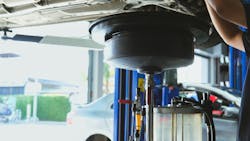Tech Tip: What you need to know about vehicle lift safety
When working with automotive lifts, it’s important to be smart and safe. Automotive lifts are responsible for lifting vehicles weighing thousands of pounds into the air to enable technicians to effectively conduct their maintenance and repair tasks. Vehicle lifts are one of the most important pieces of equipment in your shop, likely used more times per day than any other piece of equipment. Each year, thousands of automotive technicians are injured due to operating vehicle lifts, so it’s crucial to know everything about proper and safe use of automotive lifts.
Construction lift and maintenance
When working in an automotive shop, it’s vital to walk around the lift frequently to check for damage or anything that could cause an operating issue. Keeping up to date with the maintenance of your lift ensures reliable service and that you’re working safely on the job. This includes checking the lift’s wear points and welds for cracks, checking cables for deterioration, checking the hydraulic fluid level, and ensuring anchor bolts are tight at all times. Knowing the construction of your lift is vital because if one bolt or pin is not secured, it could lead to an accident.
One important feature to keep an eye on is the locking system on your lift. Most lifts have a locking system (and backup locks) that will lock the lift as the vehicle is raised. This ensures that if a cable were to break, the vehicle would “fall” to the next lock on the lift. If a vehicle falls from a lift, most of the time it’s preventable. Properly maintained and cared-for lifts should provide service for 15 to 20 years.
Different manufacturers’ lifts can be constructed differently and knowing the lift points on a vehicle will help you understand where the vehicle should be positioned. This allows for the lift to balance the vehicle at the center of its gravity as it’s suspended in the air. For extra support and when performing certain repairs such as changing a transmission or engine, a single post or tripod jack stand is recommended to help distribute the weight of the vehicle for added safety.
Information provided by Atlas Automotive Equipment.
